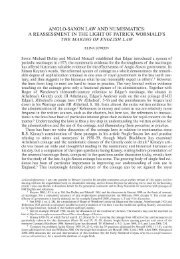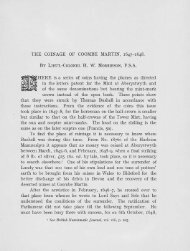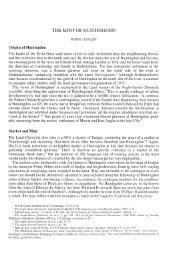JACOBITE DRINKING GLASSES AND THEIR RELATION TO THE ...
JACOBITE DRINKING GLASSES AND THEIR RELATION TO THE ...
JACOBITE DRINKING GLASSES AND THEIR RELATION TO THE ...
Create successful ePaper yourself
Turn your PDF publications into a flip-book with our unique Google optimized e-Paper software.
Jacobite Drinking Glasses<br />
In so doing I must admit that I am unable to produce any new<br />
facts or data which advance our knowledge of Jacobite medallic<br />
art, except in one instance, but.as I see it, the fact that the Jacobite<br />
medals and badges are in several cases responsible for the inscription<br />
on the glasses, is surely evident, and if they can throw some needed<br />
light on the origin of the ideas which actuated the loyal and gallant<br />
supporters of a lost cause nearly two centuries ago, we shall not<br />
altogether have wasted our time, and this paper will not have been<br />
written in vain.<br />
I have asked various owners of some of the priceless glasses<br />
illustrated, to supply me with photographs of them, besides having<br />
similar photographs taken of such of my own specimens as will<br />
illustrate my remarks, and by this means I hope to be able to show<br />
the types and engravings of the glasses and their connection with<br />
the medallic art of the period. I therefore desire to make suitable<br />
acknowledgment to those ladies and gentlemen who have supplied<br />
me with the necessary material to enable me to " adorn my tale."<br />
The beautiful glasses of which illustrations have been handed<br />
to me by our member, Mr. Hamilton elements, are specimens which<br />
are quite without parallel, and are the gems of a wonderful collection<br />
which is one day destined to add to the treasures of the British<br />
Museum.<br />
Miss Farquhar has also provided me with photographs of some<br />
of those rare objects from her collection of Jacobite relics with which<br />
the Society has already become familiar in her papers and exhibits,<br />
and Mr. Andrew is able to lend from his collection of Jacobite medals<br />
all those which appear to have any bearing on my subject, except<br />
two, which have been obtained from the British Museum.<br />
One of these is the very rare pewter medal which was struck<br />
from an obverse made for the abortive attempt in 1708, commemorative<br />
of the alleged" Restoration of the Kingdom to James Ill,"<br />
and from a new reverse die which, Dr. Hill of the British Museum<br />
has pointed out, was broken before it was used. The medal was,<br />
therefore, only struck in pewter, because the broken die could only<br />
be used with soft metal, and it is very rare. See Figure F, p. 262.
J acobite Drinking Glasses<br />
God bless the subjects all , "<br />
And save both great and small<br />
In every station.<br />
That will bring home the King;<br />
Who hath best right to reign ,<br />
It is the only thing<br />
Can save the Nation.-Amen.<br />
In this hymn as inscribed , glass collecto rs have always considered<br />
the " true-born Prince of Wales " to refer to Prince Charles Edward,<br />
and as the glasses were probably made and inscribed to celebrate<br />
his birth on the 31st of December, 1720, they have some reason to so<br />
suppose; but there is little doubt that the anthem itself was in use<br />
long before that, and"the original reference to the " true-born Prince<br />
of Wales " was in refutation of the Whig calumny that J ames Francis<br />
Edward was not t he King' s son at all, but was sm uggled into the<br />
royal bedchamber in a warming-pan . Obviously there could be no<br />
need to emphasise the " true birth " of Prince Charles if his father<br />
were, in fact, King J ames In of England, as was then claimed by the<br />
users of these glasses.<br />
FIG . A.-MEDAL COMME MORATIVE OF BI RTH OF PRIN CE CHARLE S.<br />
(From British Numismatic J ournal, vol. iii, p. 232.)<br />
The glasses were undoubtedly made afte r the Chevalier's<br />
attempt t o regain the throne in 1715. Their t ype and style makes<br />
it certain that they are not much earlier than 1720, and from certain
and their R elation to the J acobite M edals.<br />
characteristics of the engraving and the use of the word " bliss "<br />
for" bless " on all of them, it has been suggested that they were<br />
engraved in France, but as " bliss " is also frequently used in Scotland,<br />
they may have been engraved in the North, and the birth of<br />
Prince Charles would appear to be the most likely event which they<br />
would be produced t o commemorate.<br />
On one of these glasses after the word" Amen" is the later and<br />
significant addition of the date 1749, which may be in allusion to the<br />
election of the Duke of Yor k a Cardinal of t he Churc h of Rome, an<br />
event which was considered the death blow to J acobite hopes. This<br />
glass was evidently once dedicated to him, as it bears on its other side<br />
an inscription of a later date than the hymn, reading " To His Royal<br />
Highness Prince Henry, Duke of Albany and York. "<br />
The next glass, which is definitely J acobite in origin, has long been<br />
the property of t he Wynns of Wynnstay, a house which for man y<br />
years was the " home" of t he celebrated Cycle Club. It shows, for<br />
the first time on glass, a representation of the " White Rose of Stuart "<br />
with a single bud, and is inscribed round the edge " God bless the<br />
Prince." . Doubtless this also was commemorative of the birth of<br />
Prince Charles, as the glass in this case also is contemporary with that<br />
event . .These are all the relics of very early Jacobite days that we<br />
kn ow of in glasses, except some few with coins imprisoned in t he<br />
stems to which I shall allud e later.<br />
I must here digress for a moment to touch upon the use and significance<br />
of the emblem of t he expanded White R ose on the glasses,<br />
and its relation to t he similar emblem on medals -and other J acobite<br />
relics. It has been well suggest ed that the use of this rose by the<br />
J acobites originated in the fact that J ames II had been originally<br />
Duke of York. Miss Farq uhar has an enamel portrait of Prince<br />
Charles, F igure 21, which has on the reverse a five-petalled white rose<br />
-the heraldic rose of England so much used by Henry VIII and<br />
Elizabeth- conjoined with the shamro ck and thistle. This rose was<br />
t he badge of t he" White Rose Societ y," and it also appears on the<br />
medal of 1749 known as the "Highlander" medal. M edallic<br />
Illustrations, II, 655-358. See F igure G, p. 265.
252 Jacobite Drinking Glasses<br />
The only known glasses which exhibit the true heraldic rose of<br />
five petals are two in the Royal Collection at Balmoral, which will<br />
be dealt with later, and a small late glass recently shown to me by<br />
Mr. Cecil Davis, which has no buds.<br />
FIG. B.-FIVE-PETALLED ROSE AS IT APPEARS ON <strong>THE</strong> ROSA-AMERICANA HALFPENNY<br />
IN <strong>THE</strong> COLONIAL COINAGE OF GEORGE J.<br />
(From British Numismatic Journal , vol. i, p . 271.)<br />
On all other Jacobite glasses the rose is represented with six,<br />
seven or eight petals, and any glass of the period, genuinely so<br />
engraved, whether it bears any other engraving or motto, or not,<br />
may safely be regarded as a relic of the Jacobite movement.<br />
A good deal of conjecture has centred upon this use of what I<br />
may term the "quasi-heraldic" rose on the glasses, and various<br />
fantastic theories have been advanced for the use of six, seven or<br />
eight petals, one being that each petal represented a Stuart king; but<br />
this idea is entirely exploded by the glass we last considered, which<br />
has an eight-pet alled rose, and is undoubtedly earlier than any of<br />
those with six and seven petals. The fact remains, however, that a<br />
five-petalled rose was practically never shown on the authentic club<br />
glasses, and in this essential they differ from other relics. My own<br />
opinion is that the engraver simply enlarged his rose by adding extra<br />
petals entirely at his own fancy, according to the amount of space<br />
he had at his disposal upon which to work.<br />
The rose in nearly every case was accompanied by either one or<br />
two natural buds springing from the same stem, and the use of these<br />
offshoots is, I think, intentional and emblematical. The rose represents<br />
the Chevalier" James Ill," and the two buds are his two sons
and their Relation 'to the Jacobite Medals.<br />
Prince Charles and Prince Henry. It has been suggested that when<br />
one bud only appears-as in the example just considered-it dates<br />
the glass as being either prior to the birth of Prince H enry, or subsequent<br />
to his acceptance of his'Cardinal's H at, an event which bitterly<br />
offended the Jacobite Protestants.<br />
We now come to what I may term the second series of Jacobite<br />
glasses, that is, those used by the clubs and societies, and my readers<br />
must forgive me if the chronological sequence of the glasses does not<br />
quite synchronise with events, because the third and most important<br />
series, the portrait glasses, broke into and were contemporaneous<br />
with some of those in the second series.<br />
The Cycle Club was instituted on June loth, 1710, on the birthday<br />
of the titular King J ames IIl. The Club used no special glasses,<br />
except perhaps the example we last noticed, which is still at Wynnstay,<br />
until after it was reconstructed in 1724; but it was then agreed<br />
" That the Club sh all meet at the house of Daniel Porter, Innholder<br />
in Wrexham, on the first day of May, 1724," and that a new member<br />
should be elected every month thereafter. The rules were very carefull<br />
y drawn up, and, of course, the political and treasonable nature<br />
of the Club studiously concealed. The" word " of the Societ y was<br />
" FIAT," and every member of the Club pro vided himself with a<br />
special glass in which to toast" Th e King over the Water," each<br />
standing and holding his glass over a central bowl, whilst he pledged<br />
"The King," subsequen tly kissing the star engraved on his glass.<br />
The glasses used in connection with these rites were engraved with the<br />
rose and buds, an oak leaf, or a six-p ointed star, or all of these<br />
emblems, and the 'word " FIAT."<br />
All glasses so inscribed are indubitabl y glasses of the Cycle Club .<br />
They are all of early typ es and period of glass, and present little<br />
difficulty i11 a ttribution . They were probably regularl y in use at<br />
Cycle meetings from about 1730 until the events which culminate d in<br />
Culloden, when they must have been exceedingly dangerous to possess.<br />
It is in these Cycle-Club glasses, and in the emblem of the sixpointed<br />
star, that we find our first medallic parallel in the MICAT<br />
INTER OMNES medal of 1729, Medallic Illustrations, Il, 492- 34.
254<br />
J acobite Drinking Glasses<br />
This medal has the Prince as a yo ung boy-necessarily, as he<br />
was only eight years old when it was struck-with the six-rayed star<br />
before his face. The obverse legend, MICAT INTER OMNES,<br />
FIG. C.-<strong>JACOBITE</strong> i\iEDAL WITH SIX-POINTED STAR .<br />
(w. J . <strong>AND</strong>REW COLLECTIO N.)<br />
intimates t hat " H e shines amongst all," ·and that on the reverse<br />
ALTE R AB ILLO, refers t o Prince H enry- whose bust appears on<br />
that side- as shining after him. The connection between this medal<br />
of I 729 and the undated glasses made for clubs t hen operating, is<br />
t herefore definite.<br />
In or about the year I740 John Shaw's Club and others sprang<br />
up in quick succession, and the "expanded white rose" with its<br />
buds would appear t o have been used by all of them on their glasses,<br />
sometimes in conjunction with the star and oak leaf, but of course<br />
always without the word" F IA T," which wa s special to the Cycle<br />
Club .<br />
These Club glasses with emblems but no " word," were probably<br />
all prior to the Rising of I745, for , owing to the severe and brutal<br />
measures then taken to stamp out J acobitism, and especially after<br />
Culloden, it would become too dangerous to produce or use them in<br />
such large numbers as previ ously.<br />
Differing t yp es exist wit h these symbols, but without any other<br />
emblem or motto, and I now suggest-with a full knowledge of the<br />
surprise that suggestion will give some collectors of J acobite glassesthat<br />
t hose I have alrea dy described, and only those, were the glasses
and their Relation to the]acobite Medals. 255<br />
used prior to the Jacobite Rising in 1745; and that all others, the<br />
various motto glasses, the portrait glasses, and the butterfly glasses,<br />
which last, although not hitherto definitely accepted as Jacobite<br />
relics, I hope to prove without any shadow of doubt were such, were<br />
FIG. 3. FIG. 4.<br />
CLUB <strong>GLASSES</strong> WITH EMBLEMS BUT NO "WORD."<br />
(GRA NT R. FRANCIS COLLE CTI ON. )<br />
engraved subsequently to Culloden, to keep the spirit then engendered,<br />
alive for a later attempt. To this statement, however, ' an<br />
exception must be made of un engraved glasses which contain coins<br />
in the stem. They are extremely rare, and appear to have been<br />
occasionally made between 1700 and 1750, but as they display no
Jacobite Drinking Glasses<br />
inscription or symbols, I must deal with them quite as a separate<br />
Class after the symbolic glasses . .<br />
Of glasses which simply show the expanded rose and buds I<br />
illustrate three typical examples with six, Figure 5, seven, Figure 6,<br />
FIG. 5. FIG. 7. FIG. 6.<br />
DIFFERING FORMS OF TH E ROS E ON <strong>GLASSES</strong>.<br />
(GRANT R. FR ANCIS COLL E CTI ON.)<br />
and eight petals, Figure 7, to which I have referred earlier. It will<br />
be noticed that these leave out the seriously incriminating emblems,<br />
and little exception could be taken to them, as the expanded rose<br />
was occasionally used in connections other than J acobite.<br />
I next pass to the post-Culloden period, when it must be<br />
remembered that the glamour offhe attempt, and particularly of
] acobite Drinking Glasses<br />
was not often the case wit h the doublet , which was usually selfcoloured<br />
acco rding to the fanc y of the wearer.<br />
In this connection I cannot refrain from adding a delightful .<br />
verse from an old Scottish song, for which I am again indebted to<br />
Mr. Andrew, and which is particularly appropriat e to any consideration<br />
of Prince Charles's personal appearanc e :-<br />
t c Oh! better lov'd he canna' be ;<br />
Yet when we see him wearing<br />
Our Hielan ' garb sae gracefully<br />
'Tis aye the mail' endearing.<br />
Though a' that now adorns his brow<br />
Be but a simple bonnet;<br />
Ere lang we'll see of Kingdoms three<br />
The Ro yal Crown upon It.<br />
Send round the Usquebaugh sae clear<br />
We'll tak' a horn thegither."<br />
From that period the Prince, and not his father, became the<br />
hope and idol of the Jacobites, and any glasses which have even<br />
a slight reference to Charles and not to J ames, or which show him<br />
. in Highland dress, must be post-Culloden productions. But we<br />
shall have stronger evidence in many of them than this mere<br />
st at ement !<br />
We find comparatively very few Cycle-Club glasses bearing the<br />
emblems previously described and the word " F IAT, " which have<br />
any reference to Prince Charles, but four such are known whi ch add<br />
the Prince of Wales's feathers under the foot. These four glasses<br />
were from the Oxburgh H all find , and are now in the possession of<br />
Mr. Hamilton Clements. The history of t his find is interesting,<br />
and may be narrated here from Th e Bargain B ook, by C. E.<br />
J erningham and Lewis Bettany.<br />
Mr. C. E. J erningham, the journalist and author, and an ardent<br />
glass collecto r, whilst paying a visit to Oxburgh Hall in September,<br />
1907, was discussing Jacobite relics, and particularly glasses, with
c. 8. FIG. 9.<br />
FIAT " <strong>GLASSES</strong> FR OM T HE OXI3U RGH HALL FI KD .<br />
(HAi\II L<strong>TO</strong> N- CLHIEN"TS COLLECTION.)
and their R elation, to the]acobite 1.1.1edals. " 259<br />
his host, Sir Henry Bedingfeld, who mentioned that in his youth<br />
he had heard that there' were " still some curious glasses in the<br />
house."<br />
Orders were acc ordingly given to have the contents of the<br />
china.cupboard removed to "a t able in the housekeeper's room,<br />
and when' that was done, Sir Henry and his guest went down<br />
to examine the motley collection . In the centre of hundreds<br />
of pieces of modern glass were eleven specimens of the J acobite<br />
period, which, as they were covered with dust, had probabl y<br />
not been touched for years. The B argain Book.<br />
The whole of the eleven specimens referred to were purchased<br />
by Mr. H amilton Clements. One of the glasses in this find, and by<br />
far the most interesting, is the goblet bearing the portrait of Prince<br />
Charles, flanked by the rose and thistle, and bearing in script on<br />
the reverse side the rhymed inscription :-<br />
" Charles ye Great, ye Brave, the Just and Good<br />
Brittanias Prince, ye noblest of her BId .<br />
Thy Glorious F eats the World may pr'",<br />
Brittanias Glory and Brittane Shame."<br />
The sentimen t in the verse on this glass, even if it lacks something<br />
in rh ythm, does not fail in loyal admiration! The last two<br />
lines are an . obvious allusion to t he Prince's attempt to regain the<br />
Crown for his father in 1745-46 . Charles had no " Glorious Feats"<br />
to proclaim before that event, and the allusion to "Brittani as<br />
Glory" in his " Feat '3," and" Brittane Shame " in setting a price<br />
on his head, is convincing, and makes it certain that this glass was<br />
made afte r his escape to the Continent.<br />
I have been happy, through Miss Farquhar, to have been able<br />
to trace the original of the portrait on this unique glass in a print<br />
in the British Museum, their No. 24, and to obtain a phot ograph of<br />
it . Figure 11.<br />
The original of the Museum pri nt is believed to be an oil painting<br />
by Dominique Dupra, painted in Rome in 1745. If this is so, it<br />
s 2
260 ] acobite Drinking Glasses<br />
confirms my deduction of the reason for the Prince not being shown<br />
in the print in the afterwards popular Highland dress, and for the<br />
fact that his cost ume has been altered to the tartan in the engraving<br />
on the glass, which is ot herwise faithfully copied from th e print.<br />
The oak bough shown with the helm and the Prince of Wales's<br />
feathers, which appear under the portrait in the engraving, should<br />
be noted in connection with the frequent use of oak leaves and<br />
sprays on the glasses.<br />
On the zqth of May, 1660, Charles II entered London on his<br />
restoration, and incidentally on his birthday, wearing a sprig of<br />
oak leaves, in commemoration of his escape through the agency of<br />
the Boscob el oak after the Battle of Worcester in September, 1651,<br />
and" Oak Apple Day " was instituted to commemorate the anniversary<br />
of his restoration, not of his escape. We doubtless owe the<br />
constant use of the oak leaf on Jacobite glasses to these facts.<br />
FIG. D.-<strong>THE</strong>" OAK ME DAL" OF CHARLES H.<br />
(From British Nu mismatic [ournal, vol. v, p. 251.)<br />
Connected with the Oxburgh Hall glass, and undoubtedly<br />
engraved from the same original portrait, is another important<br />
goblet, now, I am glad to say, in my own collection. . It was probably<br />
made and omamented by the same hand as Mr. Clements's glass,<br />
but, instead of the rhyme at the back, it has the rarest of the known<br />
Virgilian mottoes used at this time on the portrait glasses, HIC<br />
VIR HIC EST.
FI G. 11.<br />
PORTRAIT OF P RI NCE CHARLE S EDWARD, AFTER DOl\IINIQUE DUPRA.<br />
Original of ilie P ortraits on Figs. 1 0 and 12 .<br />
(rmITISH l\!U SE Ul\I COLLECTI ON .)
FIG. 12.<br />
PORTRAIT GOBLE T WITH " IU C VIR IIlC EST" :\IOT<strong>TO</strong>.<br />
(GRA:\T R . F RA:\CIS COLLECTIOl\.)
F IG . 13.<br />
GLASS I XSCRIB E D " AVDENTI OR IBO ."<br />
(HAilIIL<strong>TO</strong>X - CLElIlENTS COLLEC TION.)
and their Relation to the Jacobite M edals.<br />
H ebrides, and necessitates the removal of this medal in Medallic<br />
Illustrations and other works from t he date of the previous RED<br />
DITE issue with t he same obverse, 1708, to the 1745 period.<br />
Miss Farquhar has one of the very few impressions which exist of the<br />
medal, and anot her is in the British Museum. M edallic Illustrations,<br />
II, 314- 137.<br />
The invocation THVLE on this medal is very interesting<br />
when it is remembered that William of Orange had used a similar<br />
formula, <strong>TO</strong>RBAY, on the medal struck to commemorate his landing<br />
in England.<br />
After Culloden, Charles, and not his fa ther, became the centre<br />
of the J acobite hopes, and it will be noted that it is the Prince's<br />
portrait, and not the " King's," which the glass shows, and makes<br />
the significant claim for, that " This is the man." Further, all medals<br />
struck 'Subsequently to Culloden also have the portrait of Charles<br />
instead of his father, and this glass may therefore be safely attributed<br />
to 1746 or afte r, whilst the medal was struck in 1745.<br />
I should here mention that Lord Beauchamp, through Miss<br />
Farquhar, sent me a photograph of a painting in his possession which<br />
is very similar to the Museum print, our Figure II, and it was<br />
thought that this might possibly.be the origin of the portrait on these<br />
two glasses, but the somewhat coarser features and the shape of the<br />
wig in the Museum print make it apparent that that is the true original.<br />
Lord Beauchamp's portrait is also in ordinary costume, not tartan,<br />
and was probabl y painted before 1745, and possibly by J. Van Diest.<br />
Our next step takes us to the " Highlander " Medal of 1749,<br />
Medallic Illustrations, II, 655-358, and to the glasses engraved with the<br />
motto AVDENT IOR IBa, Figure 13, which may be roughly interpreted<br />
, "Next time I will go even more boldly ." This glass is the<br />
property of Mr. Clements .<br />
Mr. Crowther-Beynon , a member of our Council, has also three<br />
similar glasses, which are of special interest because they are the<br />
remains of a set which has descended as an heirloom in his family<br />
for generations , and I imagine that for three glasses with the portrait
J acobite Drinking Glasses<br />
of the Prince, and from the same set, t o thus descend into the<br />
possession of one person, is an incident quit e unique.<br />
The same portrait appears in an oval on a rare little glass in<br />
my collection which bears no ins cription of any kind, and so far as I<br />
am aware this specimen, Figure 14, and Mr. Clements's enamelled<br />
glass, Figure 23, are the only two portrait glasses not additionally<br />
embellished with some emblems or motto.<br />
F IG . 14.-GLASS WIT H <strong>THE</strong> " AVDENTIOR IBO" PO RTRAIT, BUT NO MOT<strong>TO</strong> .<br />
(GRANT R . F RANCIS COLLECTION.)<br />
The AVDENTIOR IBO glass in the collection of Mr: Clements<br />
Figure 13-and all other glasses bearing this motto have one<br />
common feature. F or they all bear the same portrait of the Prince,<br />
except one recently shown to me by Mr. Arthur Churchill, which<br />
appears to be of much later date and is in all probability merely a<br />
commemor ative glass. I have not yet found the original of this<br />
portrait , but the likeness to the tiny figure on the Highlander medal
266 ] acobite Drinking Glasses<br />
was an affiliated member of the Cycle Club. .Two very similar glasses<br />
are in the Victoria and Albert Museum, and of one of these I show<br />
an illustration-Figure Is-where the spelling is REVERESCIT.<br />
FIG . I5.- GLASS WlTH BOUR GE OXIXG OAK AXD " RE VER ESClT "<br />
(VI C<strong>TO</strong>RIA <strong>AND</strong> ALBERT lIIU SE UilI).<br />
Next is a goblet which is in Mr. Joseph Bles's collection, now on<br />
view at the Victoria and Albert Museum. The design is identical<br />
with the first-mentioned Macdonald glass, except that REVIRESCIT<br />
is in script instead of capitals.'<br />
This glass held the record aucti on pri ce for a single specimen at £395 until<br />
1924, when it was exceeded by an AMEN glass.
268 Jacobite Drinking Glasses<br />
In 1750, and again in 1752, Charles paid " secret visits " to<br />
London; that in the latter year, however, is supposed to have<br />
been kn own to and connived at by the British Government. This<br />
visit is commemorated by the medal which has the bust of Charles<br />
to the right, and the motto REDEAT MAGNUS ILLE GENIUS<br />
BRITANNI iE, ' May he the great genius of Britain return.' It<br />
is dated 1752. M edallic Illustrations, Il, 670-380. Figure K.<br />
FIG. K.-PRINCE CHARLE S " REDEAT MAGNUS ILLE " MEDAL, 1752.<br />
(BRITISH MUSEUM.)<br />
. FIG . L.-" AMOR ET SPES" ME DAL . (w. J. <strong>AND</strong>RE W COLL ECTI ON.)<br />
Other glasses made in anticipation or in commemoration of<br />
Prince Charles's visits have different mottoes and provide other types<br />
of engraving. A set which has the Prince of Wales's feathers on the
FIG. In . F IG . 17.<br />
JA COBITE GLAS SES WITH E l\InLE ::\IS AN D TH E W ORn " RE DEAT."<br />
(H Al\IIL<strong>TO</strong>N- CLH IE NTS COLL E CTIO N .)
and their R elation. to the Jacobite IVI edals. 269<br />
bowl, and the word REDEAT, is preserved in Radboume Hall, Derbyshire,<br />
the then hostile house where Prince Charles commandeered<br />
a lunch on the day that he entered Derby.<br />
A fine goblet in my own collection has the rose and two buds,<br />
the star, and the same word. Of this glass Mr. Clements has its<br />
fellow from the same set, Figure 16, and a smaller glass, shown with<br />
it, with the same inscription and details, Figure 17. This is a rare<br />
combination of symbols.<br />
Since this paper was read to the Society I have been privileged<br />
to examine the wonderful collection of glasses belonging to<br />
Mr. Kirkby Mason, which contains a very interesting series of<br />
Jacobite examples, and I must mention a REDEAT glass, which<br />
appears at first sight to throw some slight doubt upon my attribution<br />
. of all the glass es with this motto to 1750-52.<br />
Mr. Kirkby Mason's glass itself-from the evidence of both<br />
its form and detail-is considerably earlier than that, and certainly<br />
not later than 1740, and another, in the cabinet of Dr. Young, is<br />
even earlier. Of course there is no reason why REDEAT should not<br />
h ave been the club motto, or " word," before the issue of the medal<br />
struck in that year, but if we accept the inference that the official<br />
medals were the for erunners of the inscriptions on the glasses- as<br />
I think we must on the evidence I am able to produce in this<br />
monograph-then we must rule out the inscription on Mr. Kirkby<br />
Mason's and Dr. Young's glass es as having been engraved before<br />
1752 , unless we have some other corroborative evidence of the use<br />
of the word REDEAT prior to that date on the glasses, which at<br />
. present appears to be lacking. .<br />
One explanation of this apparent anomaly is very simple, and<br />
I advance it for what it is worth. The REVIRESCIT medal we<br />
know was engraved to the order of "The Oak Societ y," and it is<br />
possible that that Society was responsible for the REDEAT<br />
medal also, and, following precedent, that it adopted " REDEAT "<br />
as its" word," and inscribed it on the glasses used by its members,<br />
exactly as the Cycle Club had adopted" FIAT." Now, althoughif<br />
this is correct-that word would not be likely t o appear on a glass
270 Jacobite Drinking Glasses<br />
prior t o 1752, there was nothing t o prevent glasses made before<br />
that date being then engraved, and doubtless this was done in other<br />
instances also, and accounts for apparent discrepancies of age<br />
between individual specimens of glasses which bear identical<br />
ins criptions , and were probably engraved simultaneo usly .<br />
The R ev. Walter Woo1combe had a set of five glasses also<br />
with the rose . and buds and the star, but bearing the motto<br />
REDDAS INCOLVMEM ot herwise unknown on glasses, which<br />
.is reminiscent of the same Virgilian quotation from which the<br />
HI e VIR motto "vas t aken. Finally, in this connection , are three<br />
glasses "engraved on the bowl only, with the rose and two buds,<br />
but with the motto REDI, probably an abbreviation of REDII,<br />
" I returned, " between two oak leaves twice engraved on the foot.<br />
That illustrated is from Mr.. elements's collection, and an exactly<br />
similar glass is in the collection of Mrs. F. H . Thomas, of Elstree.<br />
It appears probable that these were commemorative of one of the<br />
royal visits. Figure I S.<br />
.We next turn again to the Cycle Club of about the same period ,<br />
1750-52, in two goblets; having a new motto, TVRNO TEMPVS<br />
ERIT. Three very similar examples are also known, which have<br />
the -Stuart six-petalled rose .and t wo buds, the word of the Cycle,<br />
"FIAT," and the six-pointed star, in addition to the motto,<br />
-TVRNO . TEMPVS ERIT. This is the only known case where a<br />
Virgilian motto is inscribed on a glass which can be definitely<br />
attributed to the Cycle Club.<br />
Another glass, otherwise identical in shape and style with the<br />
REVIRESCIT goblet, is also recorded by Sir John Risley in Th e<br />
Burlington Magazin e. The engraving -is identical with that on<br />
m y eight-pet alled rose glass, Figure 7, but it bears, in addition to the<br />
rose, an oak spray with acorns, the six-pointed star, and the motto,<br />
TVRNO TEMPVS ERIT. It would appear probable, therefore,<br />
that all glasses with this motto were made for members of the Cycle,<br />
but in the absenc e of the " word" of that organisat ion on some<br />
of them this cannot be definitely st ate d as a fact.<br />
There is yet another series of portrait glasses which may be
FI G. 18.<br />
GLASS I NSCRIB E D " REDI " BETWEEX<br />
OAK LEAVE S OX FOOT.<br />
(HA1IlL<strong>TO</strong>N- CLE1I E NTS COLLECTIOX.)<br />
FI G. 19.<br />
PORTR AIT GLASS OF P RI NCE CHARLE S<br />
E DWAR Il FACI XG LEFT.<br />
(JOSEPH BLES COLLE CTIOX.)
and their R elation to the Jacobite 111edals. _ 2 71<br />
Club relics subsequent to the Rising of " the '45," but these are somewhat<br />
of a problem. They have quite a different portrait of the<br />
Prince in profile and in a curly wig. H e is represented in the usual<br />
tartan jacket, and wearing the rib and and star of the Garter,<br />
and the whole portrait is within a wreath of berried laurel, supported<br />
on the right by the rose and bud, and on the left by a thistle and<br />
bud, with a six-rayed star between them on the reverse side of the<br />
glass.<br />
The original of a"ii ·these glasses would appear to be a very<br />
remarkable goblet, formerly the property of a Miss Taylor, of<br />
Bournemouth, which was subsequently sold at Sotheby's rooms,<br />
and is now in the collection of Mr. Joseph Bles. In the type of glass<br />
. it is very similar to, and is contemporary with, the REVIRESCIT<br />
and TVRNO TEMPVS ERIT goblets just described, but here the<br />
rose is seven-petalled , and it will be observed that the Prince is<br />
represented facing towards the left , and with the riband and star<br />
of the Garter displayed on the left breast, as is, of course, correct.<br />
Now, this fine portrait must have its protot yp e somewhere, and<br />
.for reasons which I shall give, it was probabl y a contemporaneous<br />
print, though at present I have not been able to trace it; but we<br />
have glasses with a similar portrait that present one of the most<br />
curious features of the whole series.<br />
They are of many forms and styles of glass, and probabl y this<br />
portrait is the presentment most frequently found, but with the<br />
single exception of Mr. Bles's glass, Figure 19, everyone of<br />
them exhibits the portrait reversed, that is, facing to the right<br />
instead of to the left, and with the riband and star wrongly shown<br />
upon the right breast instead of on the left . Figure 20. .<br />
The specimen here illustrated was form erly the property of<br />
Lord Lamborne, and is now in Mr. Clements 's collection . .I have<br />
examined seve ra l specimens of glasses with the reversed portrait,<br />
and have come to the conclusion that, although in most cases the<br />
glasses are of English origin -- -though I have seen one fine goblet that<br />
is probably a foreign glass-the engraving on all of them, except on<br />
Mr. Bles's specimen, was probably executed ab road. The fact that
and their R elation to the ] acobite M edals. 273<br />
portrait reproduced on the glasses, and the consequent reversing of<br />
the portrait,star and riband,was probably the result of slavish copying<br />
by foreign workmen.<br />
There is another engraved portrait in the British Museum,<br />
numbered 25, which is attributed to Robert Strange, and is undoubtedly<br />
the' original of Miss Farquhar's enamel, to which allusion<br />
has already been made, Figure 21 ; as .also of her silver medal,<br />
Figure 21A.<br />
FIG . 21. F IG . 21A.<br />
ENA1IIEL PORTRAIT OF PRINCE CHAR LE S E DWARD, <strong>AND</strong> UN IFACE SILVER MEDAL,<br />
WITH SAME PO RTRA IT, AFTE R SIR ROBERT STRANGE.<br />
(BO TH I N TH E COLLECTION OF MISS HE LE N FA RQU HAR. ) .<br />
The white cockade in the museum print, and the white rosette<br />
which supports the Order of the Thistle on the riband, also the three<br />
buttons on the right-hand side of the coat, should be specially noted<br />
in connection with the photograph of Miss Farquhar's enamel,<br />
Figure 21, which has exactly the same details and peculiarities, and<br />
there can be no question of its relation to the print, Figure 22.<br />
This portrait is also the original of a very rare glass of Mr.<br />
Clements's, Figure 23 , which is remarkable in that it is 'executed in<br />
red and white enamel and with a blue bonnet , which is not a process<br />
of embellishment usually employed in the decorating of glasses.<br />
T
274 Jacobite Drinking Glasses<br />
The details are identical on the print, the enamel, and the glass,<br />
and such likeness cannot possibly be the result of accident . The<br />
Strange portrait shows the Prince in Highland dress, and therefore is<br />
subsequent to I746; the enamel is probably of about the same period,<br />
and the glass, Figure 23, cannot well be earlier than I750j so that<br />
they are probably all contemporaries of about the last-named year.<br />
FI G. 23.<br />
E NAlIIELLED PORTRAIT GLASS.<br />
(HAMIL<strong>TO</strong>N-CLElIIE NTS COLLECTION.)<br />
Another portrait glass in Mr. elements's collection is engraved<br />
with a full-face portrait of the Prince in tartan jacket, and with the<br />
star of the Garter, a very similar portrait to that of the AVDENTIOR<br />
IBa glass, but not identical. It is flanked by the rose and one bud
and their R elation to the J acobite M edals. 275<br />
and the thistle, and it has the word CAROLVS on a label above<br />
the portrait. This is the only known glass where the Prince's name<br />
appears, and ·the t ype of the glass would appear t o indicate that it<br />
was made in 1750 or thereabouts. It was possibly commemorat ive<br />
of .one of the Prince's visits to London, either in September, 1750,<br />
or in September, 1752. Of course the engraving may be a little later,<br />
and Mr. Andrew suggests that it might be commemorative of the<br />
Prince's Jacobite succession in 1766 on the death of his father,<br />
but the glass appears t o be an earlier specimen than this date<br />
warrants. . .<br />
It is stated to have been given by the Prince off his own dinner<br />
table, following the old regal custom of the presentation of the goblet,<br />
to a member of the Berkeley-Calcott family, and there are other cases<br />
amongst these portrait glasses, and particularly in the case of the<br />
profile type, when he m ay , in exile, have-chosen this medium as an ·<br />
inexpensive way in which t o confer the. gift of his portrait upon his<br />
followers. But the statement . made by Mr. . J erningham and other<br />
glass writers, that he visited the houses of m any of his adherent s in<br />
England and Scotland in 1745 and left portrait glasses behind him,<br />
will not bear consideration. Such a fragile and bulky addition to his<br />
baggage would be impossible in the hurry and bustle of an arduous<br />
and dangerous campaign.<br />
Vve now reach a series of glasses which are equal in interest t o<br />
any that h ave gone before, as they show unfailingly and without any<br />
shadow of doubt the grad ual decay of the J acobite movement and<br />
hopes, until in the end it became little more than a sentimental<br />
memory.<br />
All these glasses have, in addition to the white rose and buds, a<br />
hovering butterfly with expanded wings. At first this emblem is<br />
delicately and beautifully engraved, but as time went on the engraving<br />
became less and less fine, the rose degenerated into somet hing<br />
very far removed from the emblem of the White Rose of York or<br />
St uart, though it still retained its distinctive feature of the six petals,<br />
and the butterfly became almost t he common mo th. Very rarely<br />
a bee was also introduced in to what we, as numismatists, may<br />
T 2
and their Relation to the Jacobite 111edals. 277<br />
bowl, but intermingled with the opaque twist in the stem are .three<br />
lines of brilliant sapphire blue, edging and centering the white. . Colour<br />
twists of this nature are met with in glasses of the period 1750-70,<br />
but I am not aware of any others than the pair in my collection,<br />
which are engraved with the Jacobite emblems.<br />
A few curious glasses must now be mentioned which appear to<br />
admit the decay of the Movement and the hopes of its supporters.<br />
FIG. 27. FIG. 28. FIG. 29.<br />
<strong>JACOBITE</strong> <strong>GLASSES</strong> TYPICAL OF <strong>THE</strong>" DECAY OF <strong>THE</strong> MOVEMENT."<br />
(GRANT R. FRANCIS COLLECTION.)<br />
The earliest has the two buds clearly severed from the stalk, and the<br />
glass bears the appropriate motto, TEMPORA MVDANTVR ET<br />
NOS MVDANTVR IN ILLIS -" The times are changed, and we<br />
are changed with them." The erroneous spelling of MVTANTVR
] acobite Drinking Glasses<br />
should be noted. This glass is in Mr. Clements's collection, and the<br />
'curious feature of it is that in shape, style and period, 1750, it is<br />
identical with the TVRNO TEMPVS ERIT and REVIRESCIT<br />
goblets, and was doubtless made at the same time and in the same<br />
factory, though its legend breathes quite a different spirit.<br />
Other rare glasses show a grub on the stalk of the rose, and the<br />
butterfly has been changed into a destroyin g moth, also in one case<br />
the rose is transformed into a daffodil growing from a sprig of oak,<br />
Figure 28, but the meaning of this transformation is not clear.<br />
Figure 29 is most unusual as a Jacobite glass in having the" cable<br />
coil" on the stem , and it also displays the symbols 'of decay in the<br />
moth and grub.<br />
.So far-as isat present known, Figure 30 is uniquein the Jacobite<br />
series; the 'gru b has now become a caterpillar, and the moth a fly<br />
approaching a: spider's web, 'whilst a spider is spinning its web<br />
between thestalks of the expanded rose and bud.<br />
Finally theroseappearedon examples with the "facet-cut stems<br />
aboutryzo to J;780;when the cause of Jacobitism had faded to little<br />
more. than :a dream, 'but still the old emblems "flourished, and probably<br />
the 'old 'toasts .were still faithfully drunk, 'irrespective of the<br />
factthatthe heroof thecause was dying in aforeignland, the very<br />
antithesis 0"£ that brilliant adventurer whose romantic campaign<br />
had won the admiration of Europe.<br />
One of these glasses has merely the rose-and a single bud, cut and<br />
polished on the bowl. Another has similar emblems, accompanied<br />
by a hovering bee. That this was merelya commemorative glass<br />
of a dead caus e is .proved by a portrait ale-glass from the late Mr. J. T.<br />
Cater's collection, which was sold at Sotheby's in 1919. It was<br />
elaborately engraved with a full-f aced portrait of Prince Charles on<br />
one side and Britannia on the other, both in wreaths, with a sixpetalled<br />
rose and two buds, and a thistle and two bees. It was<br />
eviden tly, 'as Sir John Risley says in Th e Burlington, " a late glass<br />
'of a - purely commemorative nature, and although of less interest<br />
than other portrait glass es which were contemporar-y with the Movement<br />
it realised 220 guineas."
FI G. 30.<br />
GLASS EN GRAVE D WITH :\ SPIDER <strong>AND</strong> WEB, A FLY, A?\ D A CATE RP ILL AR.<br />
(GRA NT R . F RANCIS COLLECTION.)
and their Relation to the Jacobite 111edals. 279<br />
With regard to those glasses which have butterflies and bees in<br />
conjunction with the·White Rose of Stuart, it has been held by many<br />
glass experts that they are not definitely Jacobite specimens; but<br />
this only goes to show how little the subject and meaning of<br />
.emblem atic engraving has been considered. The butterfly is ·the<br />
admitted emblem of the " R eturn of the Soul. " The soul of the<br />
Jacobite Movement was Prince Charles Edward Stuart. What more<br />
beautiful idea, and more t ypical emblem, could be used after his<br />
defeat at Culloden, and his escape in 1746, than to add the butterfly<br />
or the bee to the emblems of the cause for use when ·toasting "The<br />
Return of the Soul" of the Movement?<br />
The butterfly, the bee, and REVIRESCIT have all precisely<br />
the same meaning and were used with the same intent, but if further<br />
assurance is required by any who still may doubt, I will quote the<br />
following ext ract sent me by Mr. Andrew:-<br />
The connec tion between bees and the soul was once<br />
generally maintained; hence Mahomet admits bees to P aradise.<br />
Porphyry says of fountains that they are " adapte d -to the<br />
nymphs, or to those souls which the ancients called bees."<br />
Finally, no less than three families of the Stuart clan in Scotland<br />
--Stuart of Gairntully, Stuart of Balcaskie, and St uart of Tongorthuse<br />
one or two bees as their crest to this day !<br />
Before closing my remarks th ere is just one other ext remely rare<br />
type of glass which is problematically J acobite, and certainly numismatic,<br />
to which I must refer, namely, those which are called " coin<br />
glasses." Nosuch glasses are known prior to 1688, but from that<br />
date onwards several specimens exist , and I am the fortunate possessor<br />
of two of them. Glasses of the late seventeenth and early eighteent h<br />
cent uries with coins of William IH and Anne imprisoned in a bulb in<br />
the stem are known, and these are necessarily not Jacobite, but we<br />
come then to several glasses which, although a little later in period,<br />
almost invariably enclose earlier coins-for inst ance, of Charles Hand<br />
these two facts lead one to ask why?<br />
One such glass is in t he Slade collection in the British Museum.
280 ] acobite Drinking Glasses<br />
The late Albert Hartshorne, author of Old English Glasses, the<br />
standard work on English glass, whilst stating that the coin is<br />
misleading, goes on to say : "The glass can hardly be later than the<br />
time of William IlL" In this, however, he is decidedly wrong, for<br />
although there are early characteristics, such as the " prunts " or<br />
strawberries which decorate the hollow bulb' containing the coin,<br />
and the early type of lip engraving, the stem itself clearly dates the<br />
glass some thirty or even forty years later than the period attributed<br />
to it by him. The coin in this glass is a threepence of Charles Il,<br />
1679. See Figure 31. Mr. Hartshorne himself had a similar specimen<br />
containing a sixpence of Charles Il, and the fact that both these<br />
glasses contained coins of that King evidently misled even so<br />
'prominent an expert .<br />
That he was misled is proved by an almost similar glass.to the<br />
first named, which is in.the Victoria and Albert Museum. It contains<br />
a twopence of George II dated 1746, which is also approximately<br />
the date of both the glasses described by Mr. Hartshorne, and this<br />
coin was doubtless put into the glass as one of those Hanoverian<br />
counterblasts to Jacobite methods and customs, which the history of<br />
the glasses of the period so frequently displays in the" Liberty,"<br />
" Williamite," and other examples which are foreign to our subject.<br />
To return to the use of coins of Charles Il, Mr. Hartshorne says :-<br />
It is almost inconceivable that coins of Charles II would<br />
have been put into glasses out of respect.t o him after the time of<br />
William and Mary, nor was it likely that such long posthumous<br />
honours would be offered to him at the time of the 'IS and '45,<br />
and one would rather have expected a coin of J ames Il.in a<br />
Jacobite glass of the eighteenth century, but no such example<br />
has come under the author' s notice.<br />
In his premises Mr. Hartshorne was right, but in his conclusionas<br />
I sh all hope to show-he was wrong, and this led him to date<br />
glasses containing coins of Charles II as " Not later than the time of<br />
William and Mary,', though the glasses themselves should have<br />
prevented him falling into such an error. Hartshorne, however, was
FI G. 31.<br />
COIN GLASS WITH THREEPENCE OF CHARLES II I N STEnI.<br />
(BRITISH nIUSEUnI COLL ECTI ON .)
1'1(;. 82.<br />
COIN GL\SS WITU PE1\l\ Y OF C1L \ R L ES II })( STE:"I r.<br />
(GRANT R. FRA;\CIS COLL ECTI ON .)
· and their Relation to the Jacobite Medals. 28I<br />
not a numismatist, and could not be expected to know how comparatively<br />
rare are the coins of J ames H, and how extremely<br />
numerous are those of his predecessor. Herein lay the explanation,<br />
and certainly the Carolean coins were notput into the glasses in honour<br />
of the King, then dead sixty years previously.<br />
FIG. 33.<br />
COIN GLASS WITH THREEPENCE OF JAMES II IN STEM.<br />
(GRANT R. FRANCIS COLLECTION.)<br />
It must be remembered that only the coins of Charles and James<br />
would serve the purpose of the Jacobites in I746, because they did<br />
not recognise the subsequent monarchs, and this alone would account<br />
ior the frequent use of coins of Charles n. All those subsequent to<br />
the reign of J ames II would, of course, be excluded.
282 J acobite Drinking Glasses<br />
The first of my own tw o glasses is certainly early, for it has the<br />
baluster stem containing an elongate d tear, the coin bulb is decorated<br />
with four strawberries or t t prunts," and the coin is a silver penn y of<br />
Charles Il, dated 1681 ; therefore, but for the evidence of the Slade<br />
collection and Victoria and Albert specimens, I should have considered<br />
that, or a year or t wo later, to be the approximate date of the<br />
glass. On t he evidence of those two .specimens , however, I must<br />
conclude that the glass is quite thirty years later than the date of<br />
the coin, and I firml y believe it to be a Jacobite relic of the,t ime of<br />
the '15, Figure 32.<br />
Mr. Kirkby Mason has t wo very similar glasses containing coins<br />
of Charles Il, one highly interesting in -that it has a hammered penny<br />
of Simon's coinage in the stem .<br />
My second glass may, I think, be considered to clinch the matter,<br />
because this glass cannot be earlier than J746, and may be as late<br />
as 1750 from its stem and general characteristics. It also provides<br />
the example that had never come under Mr. Hartshorne's notice, and<br />
whilst in every respect , except ·in ·its opaque twist stem, it is like<br />
Mr. Hartshorne's own glass 'as to bowl, collars and foot, and the coin<br />
bulb is identical, it contains the" missing link " in a threepence of<br />
J ames Il, dated 1686. Figure 33. Mr. Kirkby Mason has an earlier<br />
glass containing a Maundy groat of the same king, and these are the<br />
only t wo known glasses in which :specimens of J ames Il's coins<br />
are used.<br />
Now it is quite impossible that these coins would be used to<br />
decorate glasses such as Figure 33, which was made at the very time<br />
when the J acobite Movement was at its height, without set purpose ;<br />
and I am convinced that all the glasses between 1715 and 1750 which<br />
cont ain Charles Il's coins , as well as my own and Mr. Kirkby Mason's<br />
glasses enclosing James Il's coins, are as definitely J acobite as if they<br />
bore the portrait of Prince Charles himself, just as I feel equally<br />
certain that glasses containing coins of William IIl, George I , and<br />
George Il, of . the same period, are as much anti-Jacobite as are<br />
the glasses engraved " To the immortal memory of King<br />
Willi am."
F IG . 3 4 .-PRINCE CHARLES EDWARD IN 1748.<br />
From a print by Wille, after L. Tocque, with that date.<br />
(GRANT R. FRANCI S COLLE CTION.)
PROCEEDINGS<br />
OF <strong>THE</strong><br />
BRITISH NUMISMATIC SOCIETY<br />
SESSIONS 192 I AN D 1922.


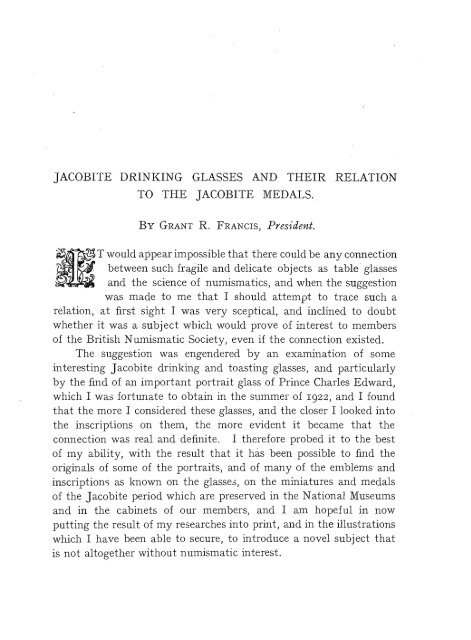
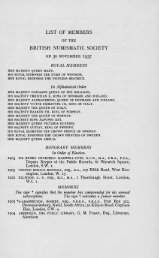

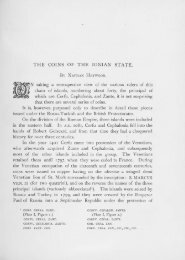
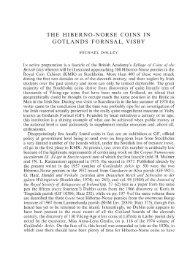
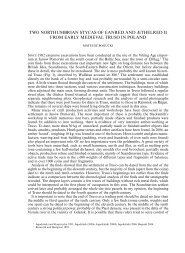

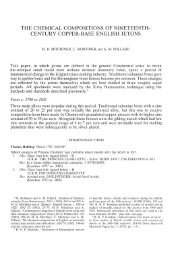
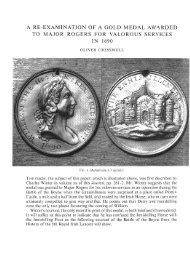
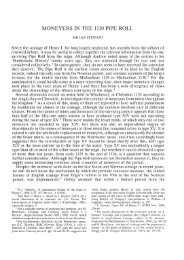
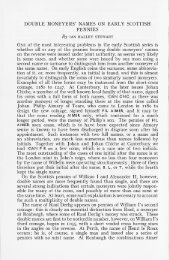
![Two Anglo-Saxon notes: [1] A Cnut die-link between the mints of ...](https://img.yumpu.com/15433998/1/189x260/two-anglo-saxon-notes-1-a-cnut-die-link-between-the-mints-of-.jpg?quality=85)
